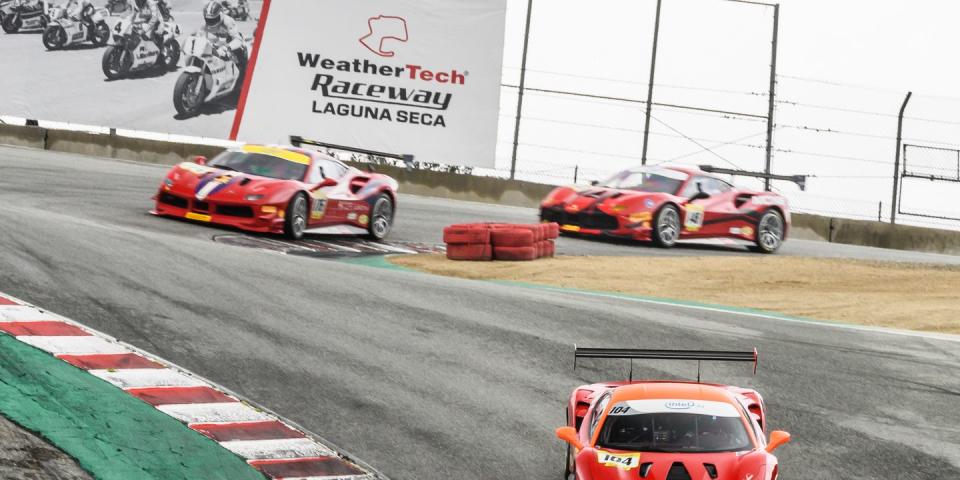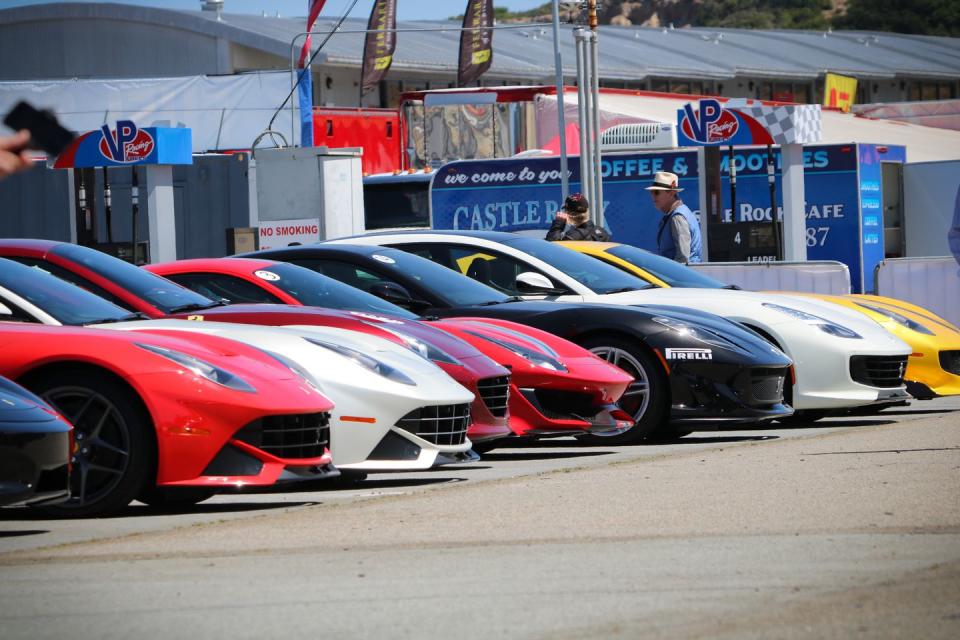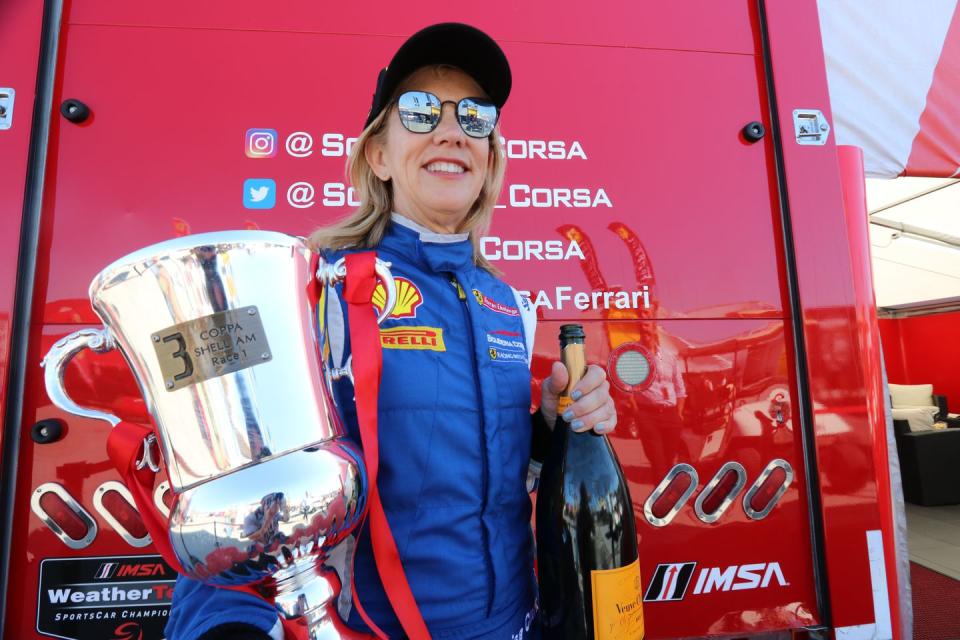We Meet Ferrari Owners Who Really Drive

If you mostly see Ferraris at shows and concours, you could mistake the owners for poseurs who never really extract everything their cars are designed to do at the limit. It turns out, though, that a great many American Ferrari owners know how to have a good time. For evidence, you need look no further than the participants in the North American region of the company's Ferrari Challenge championships.
Since the single-marque racing series fired up some 27 years ago, it has offered mono-spec Ferrari race cars-lightly modified 348s back then, 661-hp 488 Challenge race cars today-to existing customers who desire to engage in weekend-long racing events every couple of months. There are different regional championships-Europe, North America, and Asia Pacific-each divided into four talent-based divisions.
"For whatever reason, the drivers in the U.S. have kept the mentality of the original spirit of the challenge, which is for the Ferrari owner who wants to enjoy driving a Ferrari race car on the track," said Didier Theys. He's head coach for the Ferrari Challenge North America. The accomplished Belgian has had the job since shortly after he retired from professional racing in 2009. He won 18 sports-car endurance races, including the Daytona 24 twice and the Sebring 12-hour race once. He claimed 10 victories, the most of any driver, at the wheel of a Ferrari 333 SP.
Theys sat down with us during Ferrari Racing Days at Weathertech Raceway, Laguna Seca, which included a full schedule of Ferrari Challenge races. There, we discussed how the Challenge helps drivers make the most of their investments and have a good time doing so. And he emphasized that, here in North America, the drivers don't take things with excess seriousness or let pro-racing ambitions get in the way of fun.

"We try not to have the Ferrari Challenge be a steppingstone formula to being professional. More of our drivers in the U.S. are 'gentleman drivers' than in Europe, where we get more professional, younger people," he said. "There's nothing wrong with [professional ambitions]; it's just not the core of the program. The core is for the owner to get to enjoy driving on the racetrack."
How hard can that be? We spoke to drivers Ted Giovanis and Lisa Clark, each of whom told us how they have "gotten to enjoy" driving their Ferrari race cars on the track. They told us it's more involved than just getting out there and pushing the loud pedal.
Ted Giovanis: Track Time, Please, with a Side of Self-Improvement

"I have the faster versions of most of the cars I have." said Maryland-based Ted Giovanis. His daily driver is a Ferrari 458 Speciale, which is indeed faster than the workaday 458 Italia, and just outside our perch inside a gleaming red Scuderia Cava team trailer in which our chat took place sat his 661-hp 488 Challenge, which is faster than either. Giovanis, 73, is the director of a medical research foundation bearing his name (the Jayne Koskinas Ted Giovanis Foundation for Health and Policy) and had just returned from a practice session. Giovanis started racing at the club level in 1991, subsequently forming a team that eventually went pro in 2006.
"Fundamentally, I wanted more time on tracks I don't normally run on," he said. The powerful 488 Challenge race car, with its twin-turbocharged 3.9-liter V-8, prompted him to play it safe in 2018, sticking to familiar tracks. "The 488 is a great car. It's got more power, it's a way to move up. It's got aero. It's got a lot of things I don't normally get exposed to.

"The dashboard electronics are very helpful," he said, specifically mentioning how a data screen informs the driver if he or she is driving ahead of a reference lap. "If you are ahead of your fast time, it'll go purple and display a negative number; if you're slower, it shows a positive time and you can relate that to what you just went through-did I have traffic? Did I mess up or hit a curb? You're looking for collective inputs so you can leverage them all."
Theys had explained the one-driver, one-coach policy that effectively tethers drivers to their coaches, morning, noon, and night. Most coaches are active pro racers themselves and not only help with the on-track driving but also ensure the driver gets enough rest, food, and water, helping drivers stay focused and in a positive mindset. "The instruction is really good," Giovanis said. "You get instructors that are dedicated to you. You also sometimes get help from other coaches, too."
That instruction feeds Giovanis's thirst to improve as a driver, which seems to be his primary focus during 2019, taking priority over winning. "My philosophy about driving is it's all about personal improvement, which involves a lot of criticism and inputs-as much as you can get. If you don't know what you're doing wrong, you can't fix it. And so my focus is on improving myself. Then the me-vs.-the-other-guys takes care of itself."
Lisa Clark: From Trepidatious to Trophy Winner

We caught up with Challenge driver Lisa Clark later that day as she returned to the Scuderia Corsa team trailer toting a giant silver trophy in one hand and a magnum of Veuve Clicquot in the other. Her third-place finish in Race 1 of the Ferrari Challenge Coppa Shell AM series became her second podium finish this year after a second place Sebring. Then, in the Coppa Shell AM series' second race the following day, Clark once again took third place, and at the time of this writing, she ranked #1 in the Coppa Shell AM class points. "This has been amazing," Clark said. "I don't want to quit."
The 58-year-old lives in Southern California but grew up riding dirt bikes in Phoenix. She enjoyed some autocrossing in the 1980s in a Porsche 914 but put racing aspirations aside until her two daughters were grown and the family finances enabled her to pursue a passion. When commissioning her first Ferrari, a California, her dealer told her that she could drive on the track through Ferrari's Corsa Pilota training programs. "I was like, 'Sign me up!' And I got hooked," she said. But when that same dealer later suggested that Clark could actually race a Ferrari with the dealer's Challenge team, in came self-doubt and the added pressure of being a woman in motorsports. "I thought, 'Oh my gosh, I don't know, competitively, if I'm good enough. And a woman in motorsport-at my age-I didn't want to come in at the bottom and get beat up."
After completing several Corsa Pilota classes at Circuit of the Americas in Texas and Mont Tremblant in Canada, plus a few seasons racing go-karts and racing in some EXR events in Europe, and with encouragement from the Scuderia Corsa team, Clark finally took the plunge, entering the Ferrari Challenge in 2017 with a 458 Challenge Evo.

She upgraded to a blue-and-yellow 488 Challenge for 2019. There are palpable differences between the two, she says. "The 458 is more organic-you really get to drive it," she said. The more responsive 488 "can get out from under you" but boasts more advanced technology inside. "I like the braking on this car better, too. It stops a lot quicker and is more stable."
We asked Clark what clicked that could make 2019 her breakout year. "I think it's my racecraft. Being a more aggressive driver. More attentive. This is a new car, and it's a different style. It has more horsepower, but that's never scared me. It's also about the other drivers, trusting, getting to know the other guys and also seeing their styles-what kind of person they are behind the wheel-because you have all types and people change. And having a coach is great, it keeps you in that mindset, they teach from experience. They make sure you're not taking as many stupid chances that you're not aware that you're doing."
Finally, we discussed what it's like to be one of only three female drivers in the Ferrari Challenge North America. "It's been great. The men are generally very respectful. Everyone is so encouraging." And apparently, Clark said, some of the wives of other racers say they like watching her more than their own husbands. "I love being in the position to inspire women of any other age, or little girls. Because when you're in the car, it doesn't matter if you're a guy or a girl."
Thanks, Coach
Dividing the championship into four talent-based divisions-Trofeo Pirelli/Trofeo Pirelli AM/Coppa Shell/Coppa Shell AM-helps drivers stay challenged without feeling intimidated. Theys does background research on new clients, even calling the dealer to find out what sort of person they are and how they treat others. Theys gets to know all the drivers on a first-name basis, not only as a sign of respect but in order to pair them with the right coaches-he has a roster of some 70 coaches in A, B, and C categories and provides the names of five of them to new drivers when they sign up.
That's a fair bit of work on the part of a whole lot of people. And here you thought enjoying driving a Ferrari on a racetrack would be easy.
('You Might Also Like',)

 Yahoo Autos
Yahoo Autos 